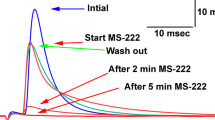Summary
1. The effects of heavy metals (Pb2+, Hg2+, and Zn2+) on synaptic transmission in the identified neural network ofHelix pomatia L. andLymnaea stagnalis L. (Gastropoda, Mollusca) were studied, with investigation of effects on inputs and outputs as wells as on interneuronal connections.
2. The sensory input running from the cardiorenal system to the central nervous system and the synaptic connections between central neurons were affected by heavy metals.
3. Lead and mercury (10−5−10−3 M) eliminated first the inhibitory, then the excitatory inputs running from the heart to central neurons. At the onset of action lead increased the amplitude of the excitatory postsynaptic potentials, but blockade of sensory information transfer occurred after 10–20 min of treatment.
4. The monosynaptic connections between identified interneurons were inhibited by lead and mercury but not by zinc. Motoneurons were found to be less sensitive to heavy metal treatment than interneurons or sensory pathways.
5. The treatment with Pb2+ and Hg2+ often elicited pacemaker and bursting-type firing in central neurons, accompanied by disconnection of synaptic pathways, manifested by insensitivity to sensory synaptic influences.
6. Zn2+ treatment also sometimes induced pacemaker activity and burst firing but did not cause disconnection of the synaptic transmission between interneurons.
7. A network analysis of heavy metal effects can be a useful tool in understanding the connection between their cellular and their behavioral modulatory influences.
Similar content being viewed by others
References
Audesirk, G. (1987). Effects ofin vitro andin vivo lead exposure on voltage-dependent calcium channels in central neurons ofLymnaea stagnalis.Neurotoxicology 8:579–592.
Audesirk, G., and Audesirk, T. (1984). Chronic lead exposure reduces junctional resistance at an electrical synapse.Neurotoxicology 5:1–8.
Atchinson, D. V., and Narahashi, T. (1984). Mechanism of action of lead on neuromuscular junctions.Neurotoxicology 5:267–282.
Benjamin, R. P., and Winlow, W. (1981). The distribution of three wide-acting synaptic inputs to identified neurons in the isolated brain ofLymnaea stagnalis (L).Comp. Biochem. Physiol. 70A:293–307.
Biondi, C., Fabbi, E., Ferretti, M. E., Sonetti, D., and Bolognani Fantin, A. M. (1989). Effects of lead exposure on cAMP and correlated enzymes inViviparus alter (Mollusa, Gastropoda) nervous system.Comp. Biochem. Physiol. 94C:327–333.
Clarkson, T. W. (1972). The pharmacology of mercury compounds.Ann. Rev. Toxicol. 12:375–406.
Damstra, T. (1977). Toxicological properties of lead.Environ. Health Perspect. 19:297–307.
Donaldson, E. W., and Knowles, S. O. (1993). Is lead toxicosis a reflection of altered fatty acid composition of membranes;Comp. Biochem. Physiol. 104C:377–379.
Cooper, P. G., and Manalis, R. S. (1983). Influence of heavy metals on synaptic transmission.Neurotoxicology 4:69–84.
Cooper, P. G., Suszkiw, J. B., and Manalis, R. S. (1984). Heavy metals; Effects on synaptic transmission.Neurotoxicology 5:247–266.
Eriksen, H. D. K., Andersen, T., Stenersen, J., and Andersen, R. A. (1990). Cytosolic binding of Cd, Cu, Zn and Ni in four polychaete species.Comp. Biochem. Physiol. 95C:111–115.
Gutknecht, J. (1981). Inorganic mercury (Hg2−) transport through lipid bilayer membranes.J. Membr. Biol. 61:61–66.
Kostial, K., and Vouk, V. B. (1957). Lead ions and synaptic transmission in the superior cervical ganglion of the cat.Br. J. Pharmacol. 12:219–222.
Manalis, R. S., Cooper, P. G., and Pomeroy, S. L. (1984). Effects of lead on neuromuscular transmission in the frog.Brain Res. 294:95–109.
Müller, T. H., Swandula, D., and Lux, H. D. (1989). Activation of three types of membrane currents by various divalent cations in identified molluscan pacemaker neurons.J. Gen. Physiol. 94:997–1014.
Nordberg, G. F. (1980). Neurotoxic effect of metals and their compounds. InAdvances in Neurotoxicology (G. F. Nordberg, Ed.), Pergamon Press, Oxford, pp. 3–15.
Oortgiesen, M., van Kleef, R. G. D. M., Bajnath, R. B., and Vijverberg, H. P. M. (1990). Nanomolar concentration of lead selectively block neuronal nicotinic acetylcholine responses in mouse neuroblastoma cells.Toxicol. Appl. Pharmacol. 103:165–174.
S.-Rózsa, K. (1979). Analysis of the neuronal network regulating the cardio-renal system in the central nervous system ofHelix pomatia L. A. Zool. 19:117–128.
S.-Rózsa, K. (1987). Organization of the multifunctional neural network regulating visceral organs inHelix pomatia L. (Mollusca, Gastropoda).Experientia 43:965–972.
S.-Rózsa, K., and Salánki, J. (1974). Retrograde intracellular staining and identification of gastropoda neurons with CoCl2.Acta Biol. Acad. Sci. Hung. 25:231–232.
S.-Rózsa, K., and Salánki, J. (1985). Effects of heavy metals on the chemosensitivity of neuronal somata ofLymnaea stagnalis L. InHeavy Metals in Water Organisms (J. Salánki, Ed.), Akadémiai Kiadó, Budapest, pp. 387–800.
S.-Rózsa, K., and Salánki, J. (1990). Heavy metals regulate physiological and behavioral events by modulating ion channels in neuronal membranes of molluscs.Environ. Monitor. Assess. 14:363–365.
S.-Rózsa, K., and Salánki, J. (1991). Ion channels of nerve membrane as targets for environmental pollutants. InBioindicators and Environmental Management (D. W. Jeffrey and B. Madden, Eds.), Academic Press, London, pp. 389–399.
S.-Rózsa, K., Salánki, J., and Présing, M. (1988). Use ofLymnaea stagnalis in monitoring heavy metal pollution. InBiological Monitoring and Environmental Pollution (M. Yasuno and B. A. Whitton, (Eds.), Tokay University Press, Tokyo, pp. 247–255.
Viarengo, A., and Nott, J. A. (1993). Mechanisms of heavy metal cation homeostasis in marine invertebrates.Comp. Biochem. Physiol. 104C:355–372.
Wang, Y. X., and Quastel, D. J. M. (1990). Multiple action of zinc on transmitter release at mouse end-plates.Pflügers Arch. Eur. J. Physiol. 415:582–587.
Winlow, W., Moroz, L. L., and Syed, N. L. (1992). Mechanisms of behavioral selection inLymnaea stagnalis. InNeurobiology of Motor Programme Selection. New Approaches to the Study of Behavioral Choice (J. Kien, C. R. McCrohan, and W. Winlow, Eds.), Manchester University Press, Manchester, pp. 52–72.
Author information
Authors and Affiliations
Rights and permissions
About this article
Cite this article
S.-Rózsa, K., Salánki, J. Modulation of synaptic events by heavy metals in the central nervous system of mollusks. Cell Mol Neurobiol 14, 735–754 (1994). https://doi.org/10.1007/BF02088681
Received:
Accepted:
Issue Date:
DOI: https://doi.org/10.1007/BF02088681




